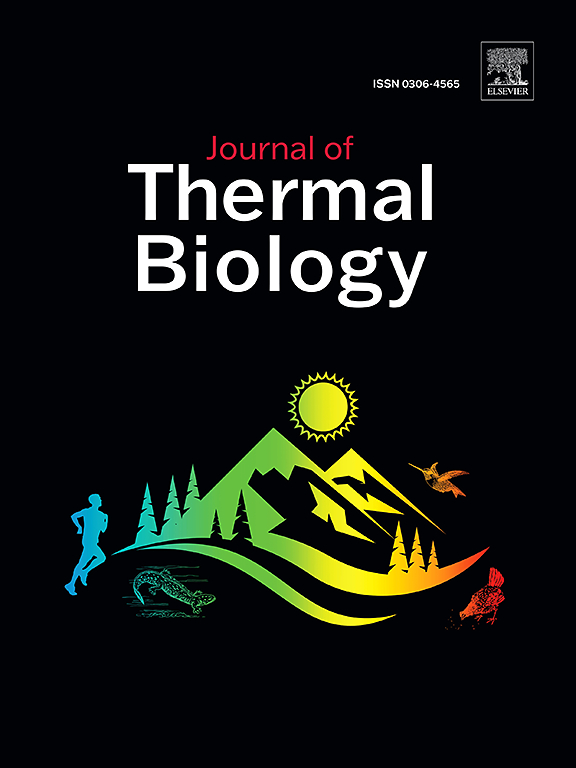Sex-specific differences in insulin response and substrate oxidation after repeated, brief whole-body immersion in 45 °C water: A prospective, interventional study
IF 2.9
2区 生物学
Q2 BIOLOGY
引用次数: 0
Abstract
Prolonged heat exposure is suggested to improve glucose metabolism and fat oxidation, but no studies have addressed whether brief heat stimuli represent a viable, time-efficient, alternative approach. Consequently, we examined the ability of brief stimuli evoked by 45 °C water to improve glucose tolerance, insulin sensitivity, and fat oxidation in young, non-obese, males and females. Twenty-four participants completed fourteen 5-min sessions involving whole body passive heating in 45 °C water. Changes in resting catecholamines, cytokines, substrate oxidation, resting energy expenditure, glucose tolerance, and insulin release in response to an oral glucose tolerance test, were assessed before and 24-h after intervention, and 1 month after the end of the intervention. The results showed that repeated short-duration heat intervention had no significant effects on epinephrine, norepinephrine, interleukin-6, and tumor necrosis factor alpha production in both sexes. Glucose area under the curve (AUC) was not affected. However, females had a lower insulin AUC and improved insulin sensitivity as indicated by a decrease in homeostatic model assessment for insulin resistance, and an increase in the quantitative insulin sensitivity check index and the Matsuda insulin sensitivity index values one month after the end of the heat intervention. No effect was observed in resting energy expenditure, but carbohydrate oxidation per kilogram increased in females, and this substrate oxidation change was maintained after one month. In conclusion, fourteen sessions of brief 5-min whole-body immersion in 45 °C water produced an improvement in insulin sensitivity and increased reliance on carbohydrate oxidation in females.
在 45 °C 水中反复短暂全身浸泡后,胰岛素反应和底物氧化的性别差异:一项前瞻性干预研究。
长时间的热暴露被认为可以改善葡萄糖代谢和脂肪氧化,但没有研究表明短暂的热刺激是否代表一种可行的、时间效率高的替代方法。因此,我们研究了45°C水引起的短暂刺激对年轻、非肥胖男性和女性的葡萄糖耐量、胰岛素敏感性和脂肪氧化的改善能力。24名参与者完成了14个5分钟的疗程,包括在45°C的水中进行全身被动加热。在干预前、干预后24小时和干预结束后1个月评估静息儿茶酚胺、细胞因子、底物氧化、静息能量消耗、葡萄糖耐量和胰岛素释放对口服葡萄糖耐量试验的响应。结果表明,反复短时间热干预对两性肾上腺素、去甲肾上腺素、白细胞介素-6和肿瘤坏死因子α的产生均无显著影响。葡萄糖曲线下面积(AUC)不受影响。然而,在热干预结束一个月后,女性胰岛素AUC降低,胰岛素敏感性改善,胰岛素抵抗的稳态模型评估减少,胰岛素敏感性定量检查指数和松田胰岛素敏感性指数值增加。在静息能量消耗方面没有观察到任何影响,但每千克碳水化合物氧化增加,并且这种底物氧化变化在一个月后保持不变。总之,在45°C的水中浸泡14次5分钟,可以改善女性的胰岛素敏感性,增加对碳水化合物氧化的依赖。
本文章由计算机程序翻译,如有差异,请以英文原文为准。
求助全文
约1分钟内获得全文
求助全文
来源期刊

Journal of thermal biology
生物-动物学
CiteScore
5.30
自引率
7.40%
发文量
196
审稿时长
14.5 weeks
期刊介绍:
The Journal of Thermal Biology publishes articles that advance our knowledge on the ways and mechanisms through which temperature affects man and animals. This includes studies of their responses to these effects and on the ecological consequences. Directly relevant to this theme are:
• The mechanisms of thermal limitation, heat and cold injury, and the resistance of organisms to extremes of temperature
• The mechanisms involved in acclimation, acclimatization and evolutionary adaptation to temperature
• Mechanisms underlying the patterns of hibernation, torpor, dormancy, aestivation and diapause
• Effects of temperature on reproduction and development, growth, ageing and life-span
• Studies on modelling heat transfer between organisms and their environment
• The contributions of temperature to effects of climate change on animal species and man
• Studies of conservation biology and physiology related to temperature
• Behavioural and physiological regulation of body temperature including its pathophysiology and fever
• Medical applications of hypo- and hyperthermia
Article types:
• Original articles
• Review articles
 求助内容:
求助内容: 应助结果提醒方式:
应助结果提醒方式:


